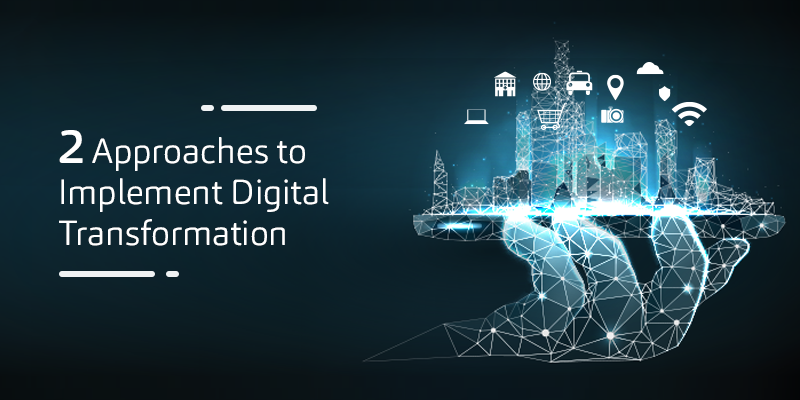Digital transformation is not a choice, it has become a necessity in today’s competitive market. Since all the enterprises are at different stages and facing different problems thus their approach to digital transformation should be different. After observing many case studies and deep research I came to know about 2 approaches to implement digital transformation.
Top-Down Approach: When an enterprise wants to transform its business model, it has to initiate by the top executive, CEO or the board. Then its flow reaches to lower layer and finally to the end employees.
Bottom-Up Approach: When an enterprise wants to transform their business processes or their way of working, they will follow a bottom-up approach. It starts affecting lower level first then reach to the top management.
As we all know, successful digital transformation requires intense planning and right approach which needs to be lead by the right leaders among the enterprise. What is right for an enterprise totally depends on their current position and desired goal for the digital transformation. Some enterprises are looking for complete transformation and others may only want to optimize one particular department and its processes. Irrespective of what type of transformation you are implementing, it requires commitment, right technology partner and a clear strategy.
Top Down Approach
When there is a change in business model required, digital transformation is initiated by the board or the CEO. These changes reflect across the enterprise starting from the value chain, value proposition and revenue model. The long-term vision needs to be well-defined and funding should be aligned to this vision. All the options are considered for transformation including HR policy, foreign strategy, marketing strategy and much more. A complete transformation is a journey which requires multiple years and it needs to be a plan in small phases.
The top-down approach is popular in consumer-facing industries like retail, insurance, banking, media, and automotive OEM. Typically led by the strategic innovators in the enterprise like talented top executive, CEO, Chief Digital Officer (CDO) and Chief Innovation Officer (CInO). Their responsibilities are not limited to innovation through technology but also includes business strategy decision like new acquisitions, new products, and service introductions.
For a top-down approach, I would highly recommend having a technology partner which can not only focus on a specific product or process but instead look for a long-term goal.
Bottom-Up Approach
This approach focuses on specific goals, like improving productivity, reduce turnaround time and optimizing the particular process. Enterprises collect ideas or concepts from their team and nominate the best. Sometimes it becomes difficult to get funding from top management for a particular department/process. The major importance is given to time, predictive maintenance, automate repetitive tasks, making internal environment safe using modern technology and so on.
This approach is popular with the asset-intensive industries like mining, chemicals, and oil and gas, where the CIO or CTO is leading the digital transformation. Focused on multiple initiatives that drive a step-change in productivity, employee engagement, and improve customer experience. Most projects are funded through the IT or divisional budget, which puts the ownership of execution on the CIO or COO.
Both approaches have their own pros and cons, but success ultimately comes when your digital initiatives are planned, prioritized and executed well. There are many companies applying both approaches simultaneously and getting good results.
Now a day more and more companies are encouraging their digital leaders to lead the transformation in the enterprise. The common goal of all the enterprise across the world is to focus on improving customer experience day by day and increasing business value by enabling digital technology.
Last year we have implemented digital transformation for one of the leading event organizing company in India - Lalloji & Sons (LJS). They are having a huge amount of inventory which is useful for various kinds of event structure, dom, chairs, lights and etc. However, up till now they where having no system to track all these inventory and many times it happened that inventory is got stolen, damaged and lost from the venue. Sometimes, they have new event and without checking their current inventory they order new inventory for the event, Which comes with a huge cost. After brainstorming with LJS’s management and on-field team we came up with a solution to track the inventory and developed robust inventory management system web & mobile application.
This bottom up approach for transformation helped LJS in tremendous way, Due to system LJS saves their huge cost, ratio of stolen inventory is reduced and ROI achieved in less than 6 months.
If you are also facing any difficulties in your process then IConflux can help you to implement digital transformation in a smooth way. Contact our expert digital transformation consultants on info@iconflux.com.



